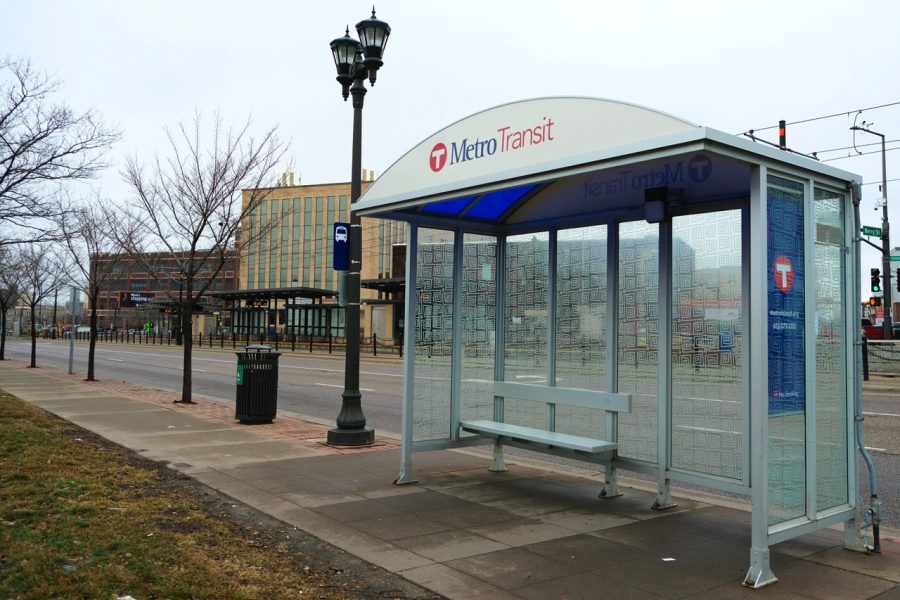Metro Transit is finalizing a plan to upgrade and replace most of bus Route 6, which runs through Marcy-Holmes, with the E Line, a Bus Rapid Transit (BRT) line that will run from the University of Minnesota area to Edina.
The BRT line will run on University Avenue through Dinkytown as part of a proposed E Line Project, which will extend south along Hennepin Avenue. The BRT line will replace the existing Route 6 line and aims to provide riders with a faster, more comfortable transit experience.
BRT buses will run every 10 minutes during most of the day, which is twice as often as Route 6. New bus stops will be similar to light rail stops. They will include heated and lit shelters, real-time arrival information, benches and ticket machines to allow customers to prepay for a ride.
The E Line, like Route 6, will have stops in downtown Minneapolis, Lake Bde Maka Ska and Edina.
According to Kyle O’Donnell Burrows, planning manager for the arterial BRT Program, BRT line project managers are reviewing feedback from public comment and will accordingly make adjustments to the planned route.
The Metropolitan Council will vote to approve the final plan later this spring, O’Donnell Burrows said. The project will be designed and engineered in late 2022, which will last at least a year, before construction begins in 2024.
The E Line is scheduled to open in 2025, according to Metro Transit’s website. Four other BRT lines are currently in development throughout the Twin Cities.
O’Donnell Burrows said the E Line project will allow for more efficient transportation within Marcy-Holmes, as well as increase accessibility to downtown Minneapolis.
“The station infrastructure is all going to be an important benefit for students … just making it more comfortable and convenient for folks to be waiting there,” O’Donnell Burrows said. “We hope that this will expand the usefulness of our transit network.”
Maximizing efficiency will come at the cost of keeping the bus stops with the highest ridership. The existing Route 6 stops at 13th Avenue and Fourth Street, 17th Avenue SE and University Avenue, and 17th Avenue SE and Fourth Street will be discontinued. The average distance between stops will increase from about a block to around half a mile.
O’Donnell Burrows said the route changes should not significantly impact riders, and “the vast majority” of new stations will be at either their pre-existing stop or within one block.
In addition to providing riders with a faster, more convenient transit, Chris Lautenschlager, executive director of Marcy-Holmes Neighborhood Association, said the upgrades will promote the use of mass transit among students and residents.
“If students or other users feel they’re reliable … it would have an incredibly good impact and promote the use of mass transit,” Lautenschlager said.
Lautenschlager said he has been a strong advocate for the E Line Project since plans were made in 2018 and helped convince developers to extend the route along University Avenue. Originally, the line was going to run from Edina to downtown Minneapolis.
A faster, more convenient rider experience will alleviate traffic congestion along Marcy-Holmes roads as more people will choose to take the bus instead of driving their own vehicle, Lautenschlager said. Additionally, fewer cars on the road will compensate for a lack of parking in Dinkytown.
“Dinkytown is less of a destination where people are coming from afar,” Lautenschlager said. “It’s more of a destination for people who are already on foot or already here.”
Although the BRT line will benefit riders, Yingling Fan, professor of urban and regional planning at the University, said she has concerns about the line potentially gentrifying the Marcy-Holmes neighborhood.
“Once you make public transportation better, more people will want to live in the area,” Fan said.
The scarcity of high-quality public transit infrastructure makes areas that have them desirable for people to live in, according to Fan. This could potentially cause an influx of new Marcy-Holmes residents and subsequently, drive rent prices up.
Fan said the best way to combat gentrification is to have more rapid transit services like the E Line so fewer people will feel the need to seek it out.
“The reason we have gentrification is because high-quality public transportation service is desirable,” Fan said. “It’s a supply and demand issue … if you provide more areas that have access to such high-quality bus services, then the gentrification likelihood will decrease.”
Image by Ray Shehadeh
The site of a proposed E-line bus stop at the intersection of University and Berry Street on Wednesday, April 6.
Metro Transit reaching final stages for E Line
The E Line is a bus rapid transit line that will replace Route 6 and connect the University area to downtown Minneapolis, Lake Bde Maka Ska and Edina.
Published April 10, 2022
9
More to Discover













